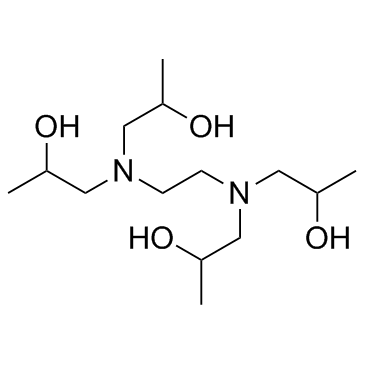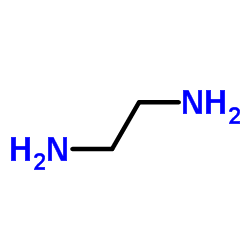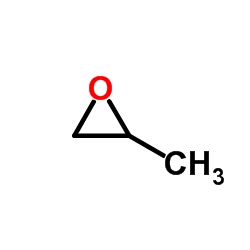Edetol

Edetol structure
|
Common Name | Edetol | ||
|---|---|---|---|---|
| CAS Number | 102-60-3 | Molecular Weight | 292.415 | |
| Density | 1.1±0.1 g/cm3 | Boiling Point | 369.1±0.0 °C at 760 mmHg | |
| Molecular Formula | C14H32N2O4 | Melting Point | 32°C | |
| MSDS | Chinese USA | Flash Point | 145.7±17.4 °C | |
| Symbol |

GHS07 |
Signal Word | Warning | |
Use of EdetolQuadrol is an immunostimulant and has been implicated as a potentially useful agent in accelerated wound healing. |
| Name | N,N,N,N-Tetrakis(2-Hydroxypropyl)- Ethylenediamine |
|---|---|
| Synonym | More Synonyms |
| Description | Quadrol is an immunostimulant and has been implicated as a potentially useful agent in accelerated wound healing. |
|---|---|
| Related Catalog | |
| In Vitro | Results show that viability of macrophages incubated with Quadrol at concentrations of 0.5 mM, 1 mM and 4mM are identical to that for controls. Viability, however, is reduced to 50% of control at concentrations of 16 mM to 32 mM. After four hours, at concentrations of 1 mM and 4 mM, Quadrol produces enhanced spreading of 88% and 80%, respectively, as compared to the control of 28%. Quadrol, at a concentration of 16 mM, shows reduced percentage of spreading of macrophages after four hours. Exposure of macrophages to 1.0 mM or 4.0 mM Quadrol concentrations enhances phagocytic activity, 41% and 57%, respectively, over that of the cells exposed to media alone (34%)[1]. |
| In Vivo | On day eight after the implantation, the amount of collagen in the implants of normal mice injected with Quadrol exceeds controls by more than 200% (p<0.025). By day 11, the collagen content increases to over 300% higher than controls (p<0.01) and by the end of two weeks after wounding, the time interval typically required for normal and complete wound healing, the collagen accumulated in the implants of the Quadrol-treated mice is about 50% above control (p<0.1). The accumulation of collagen in the implants of Quadrol treated STZ-diabetic mice about 100% above the untreated diabetic control on days 8 to 11. By day 14, the collagen deposition has increased to 200% above the controls (p<0.0 5)[2]. |
| Cell Assay | The standard trypan blue exclusion test is performed to measure cell viability (10). Cells are exposed to increasing concentrations of Quadrol (0.5 mM to 32 mM) and incubated at 37°C for varying lengths of time before treatment with trypan blue[1]. |
| Animal Admin | At the time of polytetrafluoroethylene (PTFE) tubing implantation, six test groups (3 streptozotocin-induced (STZ) diabetic and 3 non-diabetic) consisting of 5 to 7 animals per sampling time receive either diluent (control group) or Quadrol (10 mM) injected approximately 1 cm from the implantation site. The PTFE implants recovered from the mice after 2 to 14 days are stored frozen until processed and then analyzed by the HPLC method[2]. |
| References |
| Density | 1.1±0.1 g/cm3 |
|---|---|
| Boiling Point | 369.1±0.0 °C at 760 mmHg |
| Melting Point | 32°C |
| Molecular Formula | C14H32N2O4 |
| Molecular Weight | 292.415 |
| Flash Point | 145.7±17.4 °C |
| Exact Mass | 292.236206 |
| PSA | 87.40000 |
| LogP | 0.13 |
| Vapour Pressure | 0.0±1.8 mmHg at 25°C |
| Index of Refraction | 1.517 |
| Water Solubility | miscible |
CHEMICAL IDENTIFICATION
HEALTH HAZARD DATAACUTE TOXICITY DATA
|
| Symbol |

GHS07 |
|---|---|
| Signal Word | Warning |
| Hazard Statements | H319 |
| Precautionary Statements | P305 + P351 + P338 |
| Personal Protective Equipment | Eyeshields;Faceshields;Gloves |
| Hazard Codes | Xi:Irritant; |
| Risk Phrases | R43 |
| Safety Phrases | S36/37-S37-S24 |
| RIDADR | NONH for all modes of transport |
| WGK Germany | 3 |
| RTECS | UB5604000 |
| HS Code | 29221980 |
| Precursor 3 | |
|---|---|
| DownStream 0 | |
| HS Code | 2922199090 |
|---|---|
| Summary | 2922199090. other amino-alcohols, other than those containing more than one kind of oxygen function, their ethers and esters; salts thereof. VAT:17.0%. Tax rebate rate:13.0%. . MFN tariff:6.5%. General tariff:30.0% |
|
Autoclavable highly cross-linked polyurethane networks in ophthalmology.
Biomaterials 14(14) , 1089-97, (1993) Highly cross-linked aliphatic polyurethane networks have been prepared by the bulk step reaction of low molecular weight polyols and hexamethylenediisocyanate (HDI). These polyurethane networks are op... |
|
|
Sorption of Cu(II) complexes with ligands tartrate, glycine and quadrol by chitosan.
J. Hazard. Mater. 171(1-3) , 133-9, (2009) The sorption by chitosan in Cu(II) solutions containing tartrate, glycine (amino acetic acid) and quadrol (N,N,N',N'-tetrakis(2-hydroxypropyl)ethylenediamine) as ligands has been investigated. The deg... |
|
|
The behavior of organic components in copper recovery from electroless plating bath effluents using 3D electrode systems.
J. Hazard. Mater. 112(3) , 261-7, (2004) An electrochemical method was applied for the recovery of copper both from the spent solutions and from the rinse waters of electroless copper plating baths, containing copper sulfate, formaldehyde, q... |
| Edetol |
| 1,1',1'',1'''-(Ethane-1,2-diyldinitrilo)tetrapropan-2-ol |
| 1,1',1'',1'''-(Ethane-1,2-diylbis(azanetriyl))tetrakis(propan-2-ol) |
| 1,1',1'',1'''-(Ethylenedinitrilo)-tetra-2-propanol |
| N,N,N',N'-Tetrakis(2-hydroxypropyl)ethylenediamine |
| Quadrol |
| N,N,N’N’-tetra(2-hydropropyl)ethylene diamine |
| THPE |
| 1,1',1'',1'''-(ethylenedinitrilo)tetra-2-propanol |
| Entprol |
| 2-Propanol, 1,1',1'',1'''-(1,2-ethanediyldinitrilo)tetrakis- |
| EINECS 203-041-4 |
| 1,1',1'',1'''-(1,2-Ethanediyldinitrilo)tetra(2-propanol) |
| MFCD00004534 |
| 1,1',1'',1'''-(1,2-Ethanediyldinitrilo)tetrakis[2-propanol] |
| Ethylenediamine-N,N,N',N'-tetra-2-propanol |
| EDTP |




![1,1'-[[2-[(2-Hydroxypropyl)amino]ethyl]imino]bis(2-propanol) structure](https://image.chemsrc.com/caspic/329/10507-78-5.png)

